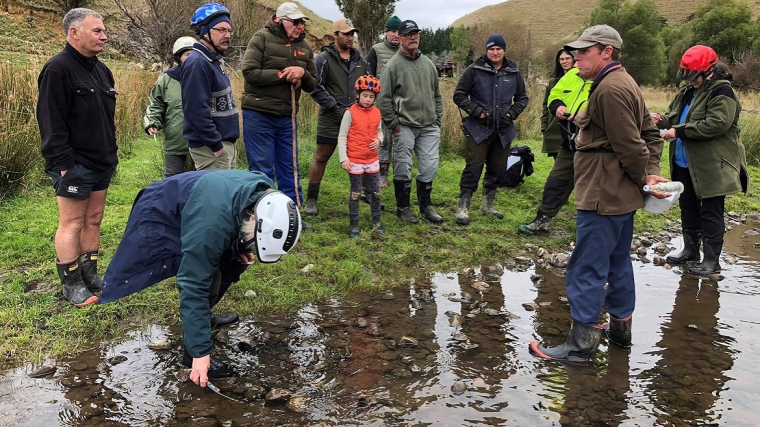
Over the next four weeks I am taking a look at catchment groups as they could very well hold the keys to ensuring farmers and rural communities continue to thrive.
In this first part I catch up with Tom Orchiston the South Island environment capability manager at Beef+Lamb. There is a wide range of work that he is involved in, from catchment groups, farm planning, winter grazing, creating various farm reserve resources, and to put in research and policy messages and to interpret those for farmers. So there's a there's a whole range of things, and catchment groups are really important to Beef+Lamb. And this goes right back to the Beef+Lamb strategy he says.
So what is a Catchment Group? There's a whole lot of different things that catchment groups could be but, the general themes that come through is generally that they are groups of people that work together in the same geographical area. And that's often centered around a lake or a river. People connect socially within that rural catchment, and they have a common goal that is being worked towards. Thriving communities and a healthy environment is a big part of a catchment groups fabric, and they're looking to improve a range of things within their communities. Within their catchments might be things like water quality, or biodiversity. But it can also be things such as looking for commercial opportunities, or even just connecting socially. So there's really a whole range of things that catchment groups are.
So what about a formal structure or governance of catchment groups?
Orchiston says “there's no one right way or wrong way, we work with a whole range of catchment groups. Some of them have, highly detailed documents, about whether they can be incorporated societies or charitable trusts, whether they set up as a business entity, but there's also a lot of Catchment groups that we work with that are completely informal structures. They don't have any particular structure or documentation, and it's very basic in form, an example is a few people that get together once in a while, and they might have a bit of a chat about various things, they might go out and do some visits to farms or waterways or rivers, they might have some projects that they work collectively on. But without having that formal structure. Having said that, the groups that have that formal structure, there's definitely some advantages to them that if they do have that formalised structure. They can then be in a position where they're able to accept funding from funding bodies, or if they want to make applications for funding, then that can be an easier mechanism. For some of them to be able to get that funding and to tap into some of those bigger funds, whether that's from regional funds, or central government, or other stakeholders.”
“Sometimes it will be easier to fund a formal entity, rather than informal. But having said that, there are several ways to kind of get around that, sometimes we find that catchment groups will have other organisations that they're aligned with or affiliated to that can act as almost like an umbrella if you will, to collect some of those funds, or applications, and then be able to pass them on to the smaller catchment groups. It can be a lot of work to set up that formal structure, so it's something that the the catchment group themselves need to think carefully about.”
Perhaps the real groundswell is coming out of catchment groups. They are after all actively working where it matters most in terms of environmental improvements, in the waterways and bringing communities together in a common goal. Collectively with over 100 catchment groups, real change could be made and indeed a real force collectively. Already you would struggle to find a more sustainable food producing nation than New Zealand, so how does the government get the balance right, in terms of setting policy to improve practices and further improve the environment, but also ensuring the primary industry remains profitable, because a lot of these changes coming to farmers will increase input costs and potentially reduce production?
Orchiston: “Yeah, absolutely. And so there's definitely an increasing number of costs that farmers are having to face. And some of those are regulatory, and some of them are driven by the markets and so on. At the same time there's always this pressure to reduce costs on farms, and to reduce the costs for the for the end consumer. So there's always that tension between those two things. And look, I'm a big believer in making sure that there's some reward and incentive for farmers to make these changes, there's often a lot of rewards, and there'll be their social social license that they will get from farming sustainably and farming well, making sure that their animals are looked after well, there's always going to be that social license from people within New Zealand.”
New Zealand needs to tell it’s story better, and being able to measure just how efficiently we produce food for export and being able to trace that back to a sub region or farm has to be the end goal for the red meat sector in this country.
Being able to tell that story behind the product goes a long way to helping consumers make that choice when they are faced with a choice. And being able to provide the evidence and whether that's through farm plans or some form of farm assurance, that goes a long way to achieving that paradigm shift in farmgate returns that farmers in this country deserve. And catchment groups can play a significant role in this process.
Listen above to hear the full story
AP Stag
Select chart tabs
Angus Kebbell is the Producer at Tailwind Media. You can contact him here.
2 Comments
Great to read about these sort of initiatives going on. As most of the media are urban based we tend to get precious little of the good stuff being done on the lands of our fathers. NZ Inc still runs on the efforts of these folk & sadly, most urbanites wouldn't have much clue about how much of our first world lifestyle is created & maintained by rural folk. Someone once told me, many years ago, that only 10% of the people in NZ actually keep the country going. The rest of us were just trading/talking amongst ourselves. He was right. And the article is right when it says that our produce has a great provenance to tell & damn it, we should tell it. The better these people in the picture do, the better this nation does, is still true today, & tomorrow, no matter what others might say.
Wrong John, thank you.
I'm no longer farming, haven't for 20+ years. But I live in a small, reasonably remote, coastal, rural community. We've got a catchment group established that is focused on the entire catchment of Porangahau River. Membership includes the whole community.
Fencing of waterways is going flat out at a cost of $20+/metre. Along with retirement of remnant bush, of which there is quite a lot in the area.
It strikes me that many of the holiday makers/tourists who pass through, note the attractive areas of totara dominant forest continuing to adorn the hills and gullies. Yet they don't connect the dots, so to speak. That being that pretty much all of those bush areas exist today because individual land owners decided to keep them on their land. Some reasons for that being aesthetic, habitat for native birds (there's quite a diversity of native birds species), shelter for livestock (sheep off the shears after late winter/spring shearing).
Most of those farmers maintain (at their own cost) bait stations for possum control, primarily for bovine TB prevention, but as a result totara, a preferred food for possums, are thriving.
Despite the best efforts of the catchment group, I doubt that we will ever see the Porangahau River running crystal clear over stoney beds, as occurs in many other rivers. That's because of the soft, sedimentary, mudstone dominant geology of the catchment. But I do anticipate improvement in in-stream habitat factors and the whitebait and eels to still run up stream for as long as the river keeps flowing.

We welcome your comments below. If you are not already registered, please register to comment
Remember we welcome robust, respectful and insightful debate. We don't welcome abusive or defamatory comments and will de-register those repeatedly making such comments. Our current comment policy is here.